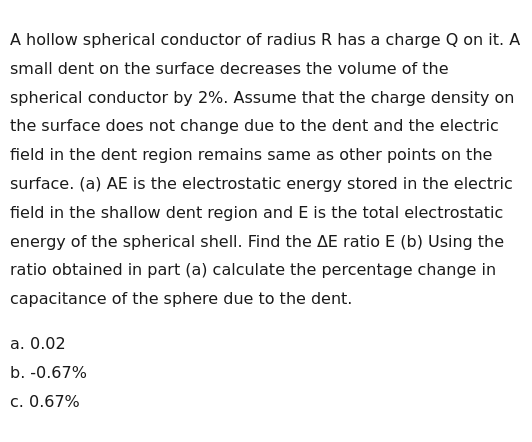Question
Question: A hollow spherical conductor of radius R has a charge Q on it. A small dent on the surface decreases...
A hollow spherical conductor of radius R has a charge Q on it. A small dent on the surface decreases the volume of the spherical conductor by 2%. Assume that the charge density on the surface does not change due to the dent and the electric field in the dent region remains same as other points on the surface. (a) AE is the electrostatic energy stored in the electric field in the shallow dent region and E is the total electrostatic energy of the spherical shell. Find the ΔΕ ratio E (b) Using the ratio obtained in part (a) calculate the percentage change in capacitance of the sphere due to the dent.

0.02 and -0.67%
Solution
Explanation of the solution:
(a) Find the ratio EΔE: The original volume of the spherical conductor is V0=34πR3. The dent decreases the volume by 2%, which means the change in volume is ΔV=0.02V0. The problem defines ΔE as the electrostatic energy stored in the electric field in the shallow dent region and E as the total electrostatic energy of the spherical shell. Assuming that the energy associated with the dent region is proportional to the volume change it causes, relative to the total energy being proportional to the original volume, we can write the ratio as: EΔE=V0ΔV Given that the volume decreases by 2%, V0ΔV=0.02. Therefore, EΔE=0.02.
(b) Calculate the percentage change in capacitance: The total electrostatic energy of a conductor with charge Q and capacitance C is given by E=2CQ2. Let the original capacitance be C0 and the original energy be E0. After the dent is made, the capacitance becomes C′ and the energy becomes E′. Assuming the charge Q on the conductor remains constant, we have E0=2C0Q2 and E′=2C′Q2. The change in energy is E′−E0=2C′Q2−2C0Q2=2Q2(C′1−C01). Let the change in capacitance be ΔC=C′−C0. For a small dent, ΔC is small compared to C0. E′−E0=2Q2(C0C′C0−C′)=2Q2C0(C0+ΔC)−ΔC. For small ΔC, C′≈C0, so E′−E0≈2C02Q2(−ΔC)=−(2C0Q2)C0ΔC=−E0C0ΔC. So, E0E′−E0=−C0ΔC.
The change in total energy is also related to the work done to deform the conductor against the electrostatic pressure. The electrostatic pressure just outside the surface of a conductor is P=2ϵ0σ2. The work done on the conductor to reduce its volume by ΔV is W=PΔV. This work increases the electrostatic energy of the conductor, so E′−E0=PΔV. For a spherical conductor, the total energy can be related to the pressure and volume: E0=8πϵ0RQ2=8πϵ0R(σ4πR2)2=8πϵ0R16π2σ2R4=ϵ02πσ2R3. Since V0=34πR3, we have R3=4π3V0. E0=ϵ02πσ2(4π3V0)=2ϵ03σ2V0. The pressure is P=2ϵ0σ2. So, E0=3PV0, or P=3V0E0. The energy change is E′−E0=PΔV=3V0E0ΔV=31E0V0ΔV. So, E0E′−E0=31V0ΔV.
Equating the two expressions for E0E′−E0: −C0ΔC=31V0ΔV. We are given V0ΔV=0.02. C0ΔC=−31×0.02=−30.02. The percentage change in capacitance is C0ΔC×100%=−30.02×100%=−32%. As a decimal, −32%≈−0.666...%. Rounded to two decimal places, this is −0.67%. The capacitance decreases due to the dent.
Answer:
(a) The ratio EΔE is 0.02. (b) The percentage change in capacitance is approximately −0.67%.
Subject: Physics Chapter: Electrostatic Potential and Capacitance Topic: Electrostatic energy of a conductor, Capacitance of a spherical conductor, Effect of shape on capacitance
Difficulty: Medium Question Type: Descriptive
